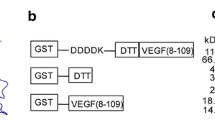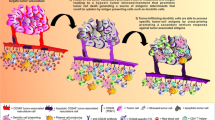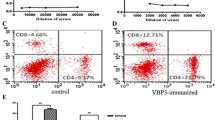Abstract
Tumor endothelial specific expression of Robo4 in adults identifies this plasma membrane protein as an anti-cancer target for immunotherapeutic approaches, such as vaccination. In this report, we describe how vaccination against Robo4 inhibits angiogenesis and tumor growth. To break tolerance to the auto-antigen Robo4, mice were immunised with the extracellular domain of mouse Robo4, fused to the Fc domain of human immunoglobulin within an adjuvant. Vaccinated mice show a strong antibody response to Robo4, with no objectively detectable adverse effects on health. Robo4 vaccinated mice showed impaired fibrovascular invasion and angiogenesis in a rodent sponge implantation assay, as well as a reduced growth of implanted syngeneic Lewis lung carcinoma. The anti-tumor effect of Robo4 vaccination was present in CD8 deficient mice but absent in B cell or IgG1 knockout mice, suggesting antibody dependent cell mediated cytotoxicity as the anti-vascular/anti-tumor mechanism. Finally, we show that an adjuvant free soluble Robo4-carrier conjugate can retard tumor growth in carrier primed mice. These results point to appropriate Robo4 conjugates as potential anti-angiogenic vaccines for cancer patients.






Similar content being viewed by others
References
Mura M, Swain RK, Zhuang X, Vorschmitt H, Reynolds G, Durant S et al (2012) Identification and angiogenic role of the novel tumor endothelial marker CLEC14A. Oncogene 31(3):293–305
Matejuk A, Leng Q, Chou ST, Mixson AJ (2011) Vaccines targeting the neovasculature of tumors. Vasc Cell 3(1):7
Haller BK, Brave A, Wallgard E, Roswall P, Sunkari VG, Mattson U et al (2010) Therapeutic efficacy of a DNA vaccine targeting the endothelial tip cell antigen delta-like ligand 4 in mammary carcinoma. Oncogene 29(30):4276–4286
Huijbers EJ, Ringvall M, Femel J, Kalamajski S, Lukinius A, Abrink M et al (2010) Vaccination against the extra domain-B of fibronectin as a novel tumor therapy. FASEB J 24(11):4535–4544
Jarosz M, Jazowiecka-Rakus J, Cichon T, Glowala-Kosinska M, Smolarczyk R, Smagur A et al (2013) Therapeutic antitumor potential of endoglin-based DNA vaccine combined with immunomodulatory agents. Gene Ther 20(3):262–273
Yoshikawa M, Mukai Y, Okada Y, Tsumori Y, Tsunoda S, Tsutsumi Y et al (2013) Robo4 is an effective tumor endothelial marker for antibody-drug conjugates based on the rapid isolation of the anti-Robo4 cell-internalizing antibody. Blood 121(14):2804–2813
Grone J, Doebler O, Loddenkemper C, Hotz B, Buhr HJ, Bhargava S (2006) Robo1/Robo4: differential expression of angiogenic markers in colorectal cancer. Oncol Rep 15(6):1437–1443
Huminiecki L, Gorn M, Suchting S, Poulsom R, Bicknell R (2002) Magic roundabout is a new member of the roundabout receptor family that is endothelial specific and expressed at sites of active angiogenesis. Genomics 79(4):547–552
Seth P, Lin Y, Hanai J, Shivalingappa V, Duyao MP, Sukhatme VP (2005) Magic roundabout, a tumor endothelial marker: expression and signaling. Biochem Biophys Res Commun 332(2):533–541
Marlow R, Binnewies M, Sorensen LK, Monica SD, Strickland P, Forsberg EC et al (2010) Vascular Robo4 restricts proangiogenic VEGF signaling in breast. Proc Natl Acad Sci USA 107(23):10520–10525
Zhuang X, Cross D, Heath VL, Bicknell R (2011) Shear stress, tip cells and regulators of endothelial migration. Biochem Soc Trans 39(6):1571–1575
Kitamura D, Roes J, Kuhn R, Rajewsky K (1991) A B cell-deficient mouse by targeted disruption of the membrane exon of the immunoglobulin mu chain gene. Nature 350(6317):423–426
Jung S, Rajewsky K, Radbruch A (1993) Shutdown of class switch recombination by deletion of a switch region control element. Science 259(5097):984–987
Naldini L, Blomer U, Gallay P, Ory D, Mulligan R, Gage FH et al (1996) In vivo gene delivery and stable transduction of nondividing cells by a lentiviral vector. Science 272(5259):263–267
Pham HM, Arganaraz ER, Groschel B, Trono D, Lama J (2004) Lentiviral vectors interfering with virus-induced CD4 down-modulation potently block human immunodeficiency virus type 1 replication in primary lymphocytes. J Virol 78(23):13072–13081
Dwyer MA, Huang AJ, Pan CQ, Lazarus RA (1999) Expression and characterization of a DNase I-Fc fusion enzyme. J Biol Chem 274(14):9738–9743
Stura EA, Fieser CG, Wilson IA (1993) Crystallization of antibodies and antibody–antigen complexes. Immunomethods 3:164–179
Wang AC, Wang IY (1977) Cleavage sites of human IgG1 immunoglobulin by papain. Immunochemistry 14(3):197–200
Cobbold SP, Jayasuriya A, Nash A, Prospero TD, Waldmann H (1984) Therapy with monoclonal antibodies by elimination of T-cell subsets in vivo. Nature 312(5994):548–551
Qin S, Cobbold S, Tighe H, Benjamin R, Waldmann H (1987) CD4 monoclonal antibody pairs for immunosuppression and tolerance induction. Eur J Immunol 17(8):1159–1165
Garside P, Ingulli E, Merica RR, Johnson JG, Noelle RJ, Jenkins MK (1998) Visualization of specific B and T lymphocyte interactions in the lymph node. Science 281(5373):96–99
Suchting S, Heal P, Tahtis K, Stewart LM, Bicknell R (2005) Soluble Robo4 receptor inhibits in vivo angiogenesis and endothelial cell migration. FASEB J 19(1):121–123
Attia MA, Weiss DW (1966) Immunology of spontaneous mammary carcinomas in mice. V. Acquired tumor resistance and enhancement in strain A mice infected with mammary tumor virus. Cancer Res 26(8):1787–1800
Toellner KM, Luther SA, Sze DM, Choy RK, Taylor DR, MacLennan IC et al (1998) T helper 1 (Th1) and Th2 characteristics start to develop during T cell priming and are associated with an immediate ability to induce immunoglobulin class switching. J Exp Med 187(8):1193–1204
Huijbers EJ, Femel J, Andersson K, Bjorkelund H, Hellman L, Olsson AK (2012) The non-toxic and biodegradable adjuvant Montanide ISA 720/CpG can replace Freund’s in a cancer vaccine targeting ED-B–a prerequisite for clinical development. Vaccine 30(2):225–230
Laitinen L (1987) Griffonia simplicifolia lectins bind specifically to endothelial cells and some epithelial cells in mouse tissues. Histochem J 19(4):225–234
Tyagi N, Roberts AM, Dean WL, Tyagi SC, Lominadze D (2008) Fibrinogen induces endothelial cell permeability. Mol Cell Biochem 307(1–2):13–22
Hariharan K, Braslawsky G, Black A, Raychaudhuri S, Hanna N (1995) The induction of cytotoxic T cells and tumor regression by soluble antigen formulation. Cancer Res 55(16):3486–3489
Toellner K-M, Gulbranson-Judge A, Taylor DR, Sze DM-Y, MacLennan ICM (1996) Immunoglobulin switch transcript production in vivo related to the site and time of antigen-specific B cell activation. J Exp Med 183(5):2303–2312
Toellner K-M, Luther SA, Sze DM, Choy RK, Taylor DR, MacLennan IC et al (1998) T helper 1 (Th1) and Th2 characteristics start to develop during T cell priming and are associated with an immediate ability to induce immunoglobulin class switching. J Exp Med 187(8):1193–1204
Siemann DW (2011) The unique characteristics of tumor vasculature and preclinical evidence for its selective disruption by tumor-vascular disrupting agents. Cancer Treat Rev 37(1):63–74
Huminiecki L, Bicknell R (2000) In silico cloning of novel endothelial-specific genes. Genome Res 10(11):1796–1806
Park KW, Morrison CM, Sorensen LK, Jones CA, Rao Y, Chien CB et al (2003) Robo4 is a vascular-specific receptor that inhibits endothelial migration. Dev Biol 261(1):251–267
Sheldon H, Andre M, Legg JA, Heal P, Herbert JM, Sainson R et al (2009) Active involvement of Robo1 and Robo4 in filopodia formation and endothelial cell motility mediated via WASP and other actin nucleation-promoting factors. FASEB J 23(2):513–522
Jones CA, London NR, Chen H, Park KW, Sauvaget D, Stockton RA et al (2008) Robo4 stabilizes the vascular network by inhibiting pathologic angiogenesis and endothelial hyperpermeability. Nat Med 14(4):448–453
Koch AW, Mathivet T, Larrivee B, Tong RK, Kowalski J, Pibouin-Fragner L et al (2011) Robo4 maintains vessel integrity and inhibits angiogenesis by interacting with UNC5B. Dev Cell 20(1):33–46
Okada Y, Jin E, Nikolova-Krstevski V, Yano K, Liu J, Beeler D et al (2008) A GABP-binding element in the Robo4 promoter is necessary for endothelial expression in vivo. Blood 112(6):2336–2339
Nagayama H, Matsumoto K, Isoo N, Ohno H, Takahashi N, Nakaoka T et al (2010) Gastrointestinal bleeding during anti-angiogenic peptide vaccination in combination with gemcitabine for advanced pancreatic cancer. Clin J Gastroenterol 3(6):307–317
Kamba T, McDonald DM (2007) Mechanisms of adverse effects of anti-VEGF therapy for cancer. Br J Cancer 96(12):1788–1795
Clark AJ, Butowski NA, Chang SM, Prados MD, Clarke J, Polley MY et al (2011) Impact of bevacizumab chemotherapy on craniotomy wound healing. J Neurosurg 114(6):1609–1616
Boles KS, Schmieder AH, Koch AW, Carano RA, Wu Y, Caruthers SD et al (2010) MR angiogenesis imaging with Robo4- vs. alphaVbeta3-targeted nanoparticles in a B16/F10 mouse melanoma model. FASEB J 24(11):4262–4270
Johansson J, Ledin A, Vernersson M, Lovgren-Bengtsson K, Hellman L (2004) Identification of adjuvants that enhance the therapeutic antibody response to host IgE. Vaccine. 22(21–22):2873–2880
Ringvall M, Huijbers EJ, Ahooghalandari P, Alekseeva L, Andronova T, Olsson AK et al (2009) Identification of potent biodegradable adjuvants that efficiently break self-tolerance—a key issue in the development of therapeutic vaccines. Vaccine 28(1):48–52
Anderson P (1983) Antibody responses to Haemophilus influenzae type b and diphtheria toxin induced by conjugates of oligosaccharides of the type b capsule with the nontoxic protein CRM197. Infect Immun 39(1):233–238
Savelyeva N, Shipton M, Suchacki A, Babbage G, Stevenson FK (2011) High-affinity memory B cells induced by conjugate vaccines against weak tumor antigens are vulnerable to nonconjugated antigen. Blood 118(3):650–659
Clynes RA, Towers TL, Presta LG, Ravetch JV (2000) Inhibitory Fc receptors modulate in vivo cytotoxicity against tumor targets. Nat Med 6(4):443–446
Parra C, Gonzalez JM, Castaneda E, Fiorentino S (2005) Anti-glucuronoxylomannan IgG1 specific antibodies production in Cryptococcus neoformans resistant mice. Biomedica 25(1):110–119
Niederer HA, Clatworthy MR, Willcocks LC, Smith KG (2010) FcgammaRIIB, FcgammaRIIIB, and systemic lupus erythematosus. Ann NY Acad Sci 1183:69–88
Karagiannis P, Gilbert AE, Josephs DH, Ali N, Dodev T, Saul L et al (2013) IgG4 subclass antibodies impair antitumor immunity in melanoma. J Clin Investig 123(4):1457–1474
Acknowledgments
This work was funded by Cancer Research UK Grant Number C4719/A7825 awarded to Roy Bicknell.
Author information
Authors and Affiliations
Corresponding author
Electronic supplementary material
Below is the link to the electronic supplementary material.
Rights and permissions
About this article
Cite this article
Zhuang, X., Ahmed, F., Zhang, Y. et al. Robo4 vaccines induce antibodies that retard tumor growth. Angiogenesis 18, 83–95 (2015). https://doi.org/10.1007/s10456-014-9448-z
Received:
Accepted:
Published:
Issue Date:
DOI: https://doi.org/10.1007/s10456-014-9448-z




